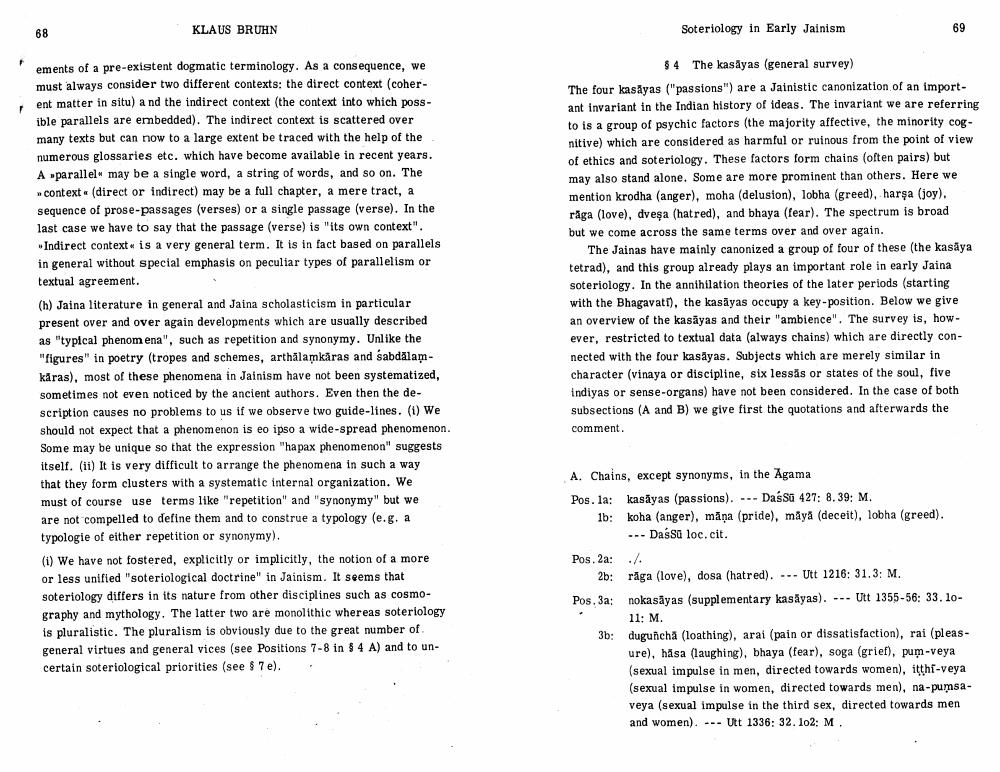________________
KLAUS BRUHN
Soteriology in Early Jainism
ements of a pre-existent dogmatic terminology. As a consequence, we must always consider two different contexts: the direct context (coherent matter in situ) and the indirect context (the context into which possible parallels are embedded). The indirect context is scattered over many texts but can now to a large extent be traced with the help of the numerous glossaries etc. which have become available in recent years. A parallele may be a single word, a string of words, and so on. The .context. (direct or indirect) may be a full chapter, a mere tract, a sequence of prose-passages (verses) or a single passage (verse). In the last case we have to say that the passage (verse) is its own context".
Indirect context is a very general term. It is in fact based on parallels in general without special emphasis on peculiar types of parallelism or textual agreement. (h) Jaina literature in general and Jaina scholasticism in particular present over and over again developments which are usually described as "typical phenomena", such as repetition and synonymy. Unlike the "figures" in poetry (tropes and schemes, arthalamkaras and sabdalamkāras), most of these phenomena in Jainism have not been systematized, sometimes not even noticed by the ancient authors. Even then the description causes no problems to us if we observe two guide-lines. (1) We should not expect that a phenomenon is eo ipso a wide-spread phenomenon. Some may be unique so that the expression "hapax phenomenon" suggests itself. (11) It is very difficult to arrange the phenomena in such a way that they form clusters with a systematic internal organization. We must of course use terms like "repetition" and "synonymy" but we are not compelled to define them and to construe a typology (e.ga typologie of either repetition or synonymy). (1) We have not fostered, explicitly or implicitly, the notion of a more or less unified "soteriological doctrine" in Jainism. It seems that soteriology differs in its nature from other disciplines such as cosmography and mythology. The latter two are monolithic whereas soteriology is pluralistic. The pluralism is obviously due to the great number of general virtues and general vices (see Positions 7-8 in 84 A) and to uncertain soteriological priorities (see $ 7e).
$4 The kasāyas (general survey) The four kasayas ("passions") are a Jainistic canonization of an important Invariant in the Indian history of ideas. The invariant we are referring to is a group of psychic factors (the majority affective, the minority cognitive) which are considered as harmful or ruinous from the point of view of ethics and soteriology. These factors form chains (often pairs) but may also stand alone. Some are more prominent than others. Here we mention krodha (anger), moha (delusion), lobha (greed), harsa (joy). rāga (love), dvesa (hatred), and bhaya (fear). The spectrum is broad but we come across the same terms over and over again.
The Jainas have mainly canonized a group of four of these (the kasaya tetrad), and this group already plays an important role in early Jaina soteriology. In the annihilation theories of the later periods (starting with the Bhagavatn), the kasāyas occupy a key-position. Below we give an overview of the kasayas and their "ambience". The survey is, however, restricted to textual data (always chains) which are directly connected with the four kasāyas. Subjects which are merely similar in character (vinaya or discipline, six lessäs or states of the soul, five indiyas or sense-organs) have not been considered. In the case of both subsections (A and B) we give first the quotations and afterwards the comment
A. Chains, except synonyms, in the Agama Pos. la: kasāyas (passions). --- Dassa 427: 8.39: M. 1b: koha (anger), māņa (pride), måya (deceit), lobha (greed).
--- Dassa loc. cit. Pos. 2a: A
2b: raga (love), dosa (hatred). --- Utt 1216: 31.3: M. Pos. 3a: nokasayas (supplementary kasayas). --- Utt 1355-56: 33. lo
11: M. 3b: duguncha (loathing), arai (pain or dissatisfaction), rai (pleas
ure), häsa (laughing), bhaya (fear), soga (grief), pum-veya (sexual impulse in men, directed towards women), itthr-veya (sexual impulse in women, directed towards men), na-pumsaveya (sexual impulse in the third sex, directed towards men and women). --- Utt 1336: 32.102: M.




